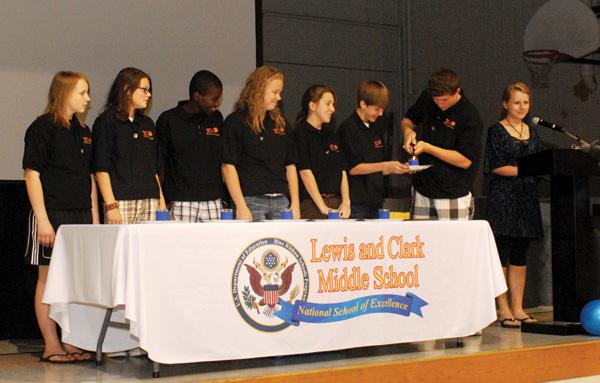School collects six million soda tabs in Holocaust memorial
Published May 27, 2010
“Six million is an atrocious number,” said Jefferson City, Mo., school teacher Beth Ayres.
She was reflecting on the completion of her school’s 13-year-long project to collect 6 million soda-pop can-opener tabs to equal the number and thus commemorate the Jewish victims of the Nazi Holocaust.
Six million can tabs comes to 32 barrels worth. One of the barrels was spilled onto the stage of Lewis and Clark Middle School last week at a commemorative ceremony, to illustrate the staggering number of which it represents but a part.
“The goal of this project … was to understand the sheer enormity,” said Ayres, a sixth-grade teacher. “I don’t think, even as an adult, I understood the number. But we have 32 barrels filled, and to think those are (representing) people… “
“One of the guests from the local synagogue said ‘I couldn’t help but think about the piles of bones, because the Nazis reduced these bodies to being less than human.’ “
‘They did get it’
Ayres said the project, which was started in 1997 by three teachers who are no longer with Lewis and Clark school, has “been really meaningful.”
“Some survivors find it offensive. They say ‘I am not a paper clip.’ And I get that,” Ayres said. “I also know that in trying to get the students to understand and connect … they did get it.”
Ayres said that the founders of the project were teachers Azelene Evans, Georgia Humphreys and Julia Koch in 1997. Ayres was the lead teacher the last couple of years.
“This project has been bittersweet,” Ayres said. “Yeah, we made our goal and had fun at times with competitions, etc. But you need to realize the Nazis did this in four years; it’s unreal.”
Ayres said Evans and Koch worked with the United States Holocaust Memorial Museum to plan the project, which is reminiscent of a Tennessee school’s plan to collect six million paper clips. That project became the subject of a documentary film.
But Ayres notes that pop-can tabs are harder to come by than paper clips; for each one, a drink must be consumed.
“Beware, if you are going to collect something, make it like a paper clip, which you can go out and buy easily,” Ayres said.
Lewis and Clark Middle School has about 950 students in grades six through eight. It had help from a couple of other Jefferson City schools, which between them chipped in about 800,000 pop tabs.
Nearly gave up
Ayres said Lewis and Clark students and faculty nearly gave up more than once during the 13 years it took to collect 6 million pop tabs.
“I didn’t become involved until barrel 24, when we reached 4 million,” Ayres said. “People said they were tired and wanted to give it up. I said ‘This is the kids’ idea, if we don’t follow through, how do our kids know we mean business?’ I was pretty valiant for three years.”
Then last year, she said, the school made “one more media push to let people know we were still doing it.” That resulted in a half-million tab donation from the Blair Oaks Elementary School in Jefferson City. (Eldon Elementary and Middle School had given 300,000 tabs in 2008.)
Present at the celebratory assembly held Friday, May 14, were the three founding teachers, plus the student whose original idea it was, Justin Perkins.
Dan Reich, education director of the Holocaust Museum and Learning Center in St. Louis, was there to congratulate the students and faculty. Project leaders pledged to donate the money they receive from recycling the pop tabs – about $1,600 – to the St. Louis museum.
Ayres said she was proud of the students and the school, which, she noted, has very little in the way of Jewish population.
“I’ve had two Jewish students in the last 17 years,” she said.
Ayres said the project, and others like it, are crucial “because the survivors are elderly and they are dying.”
“We have got to come up with some other way to pass it on to each generation,” she said.















